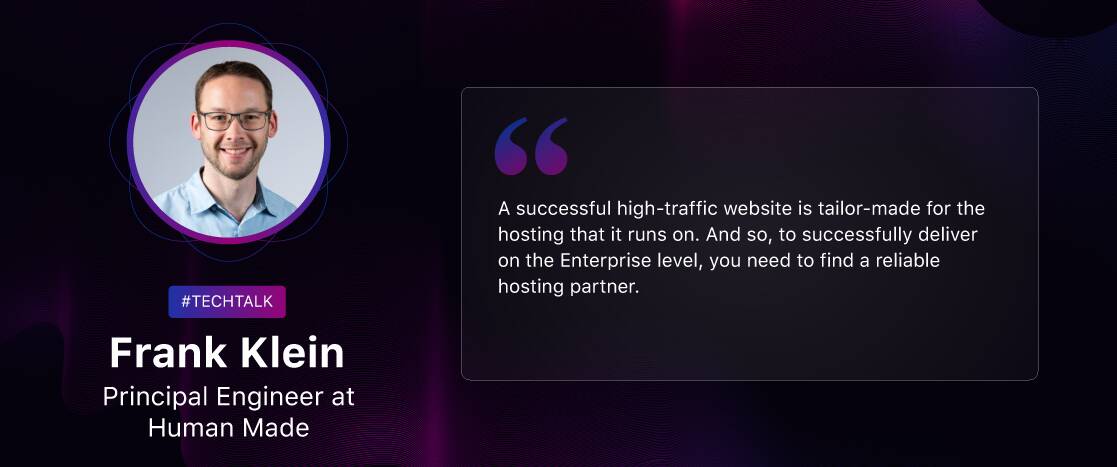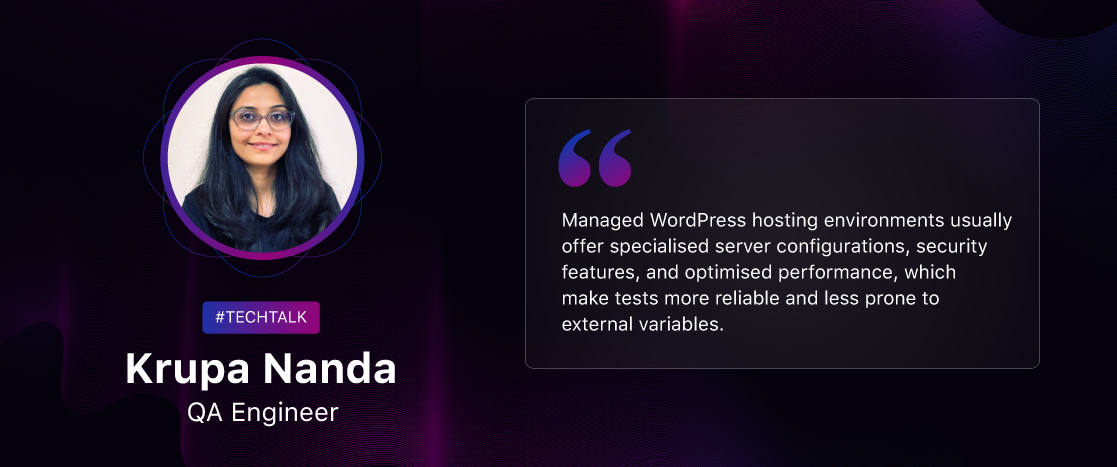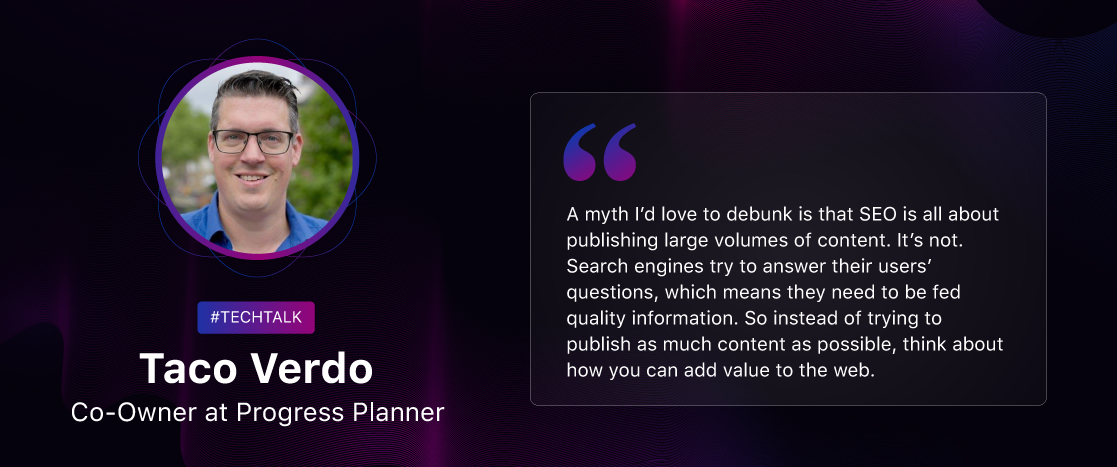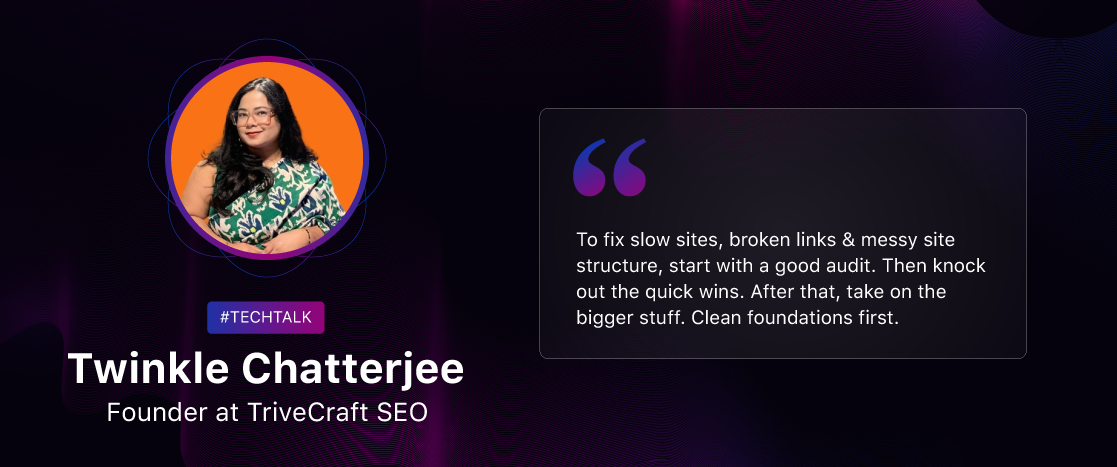
Devrims #TechTalk 063: Frank Klein Tells Why He Created WP Development Courses
Devrims: Hey Frank, how are things going these days? Can you tell us about your journey from being a self-taught developer to becoming a Principal Engineer at Human Made? And what motivated you to start WP Development Courses?
Frank: Hi, I’m doing fantastic. Thank you for inviting me to this Tech Talk Series.
My journey in web development started in 2012 after I failed as a print designer and project manager.
I graduated from university in 2008 when the economy was in shambles, and nobody hired print designers. I managed to get a job as a project manager at a web agency, but I hated it. My day was full of emails, meetings, and calls–all activities I disliked.
But one day, while browsing the web during my lunch break, I stumbled upon an article from Brian Tracey on how to change careers. That set me off on a path to learning development and becoming really good at it.
I chose my new job based on precise criteria. It needed to be a creative job in a growing market: website creation for businesses. It needed to be well-paid: development. It needed to offer lots of employment options: WordPress.
So, I ordered a PHP book from Amazon and started learning. For the next year, I worked during the day and studied and practiced programming at night and on weekends. This allowed me to transition from project management to development at the agency I was working at.
It turned out that my technical skills, coupled with my eye for design and project management capabilities, were the perfect combination. I can still remember how proud I was of my first client project, which I had done all by myself. And I was happy—I had found my calling.
But there was one big downside to this job: the two hours spent commuting every day. So I asked my boss iif I could work from home. His answer: a hard no. This was in 2013, before remote work became widely accepted.
At that time, I had been reviewing themes for the WordPress.org Theme Team and contributing code to the Twenty Thirteen default theme. This is how I learned about Automattic and their fully distributed team.
I couldn’t believe it. I could be working from wherever, whenever, for THE company in WordPress?
So, I put all my energy into building a great portfolio and applied to be a Theme Wrangler at WordPress.com. My efforts paid off: I was hired in November 2013.
And here I found something that I had been missing before: developers who were way better than me. There’s only so much you can learn from books. Seeing how developers solve problems in their daily lives made a huge contribution to my career.
After a year, I switched to WordPress VIP, where I dove into the world of Enterprise WordPress. Working at VIP was great, but I was only reviewing code and building internal tools. I wanted to not only look at the code of these high-traffic sites, but I wanted to actually build them.
This led me to Human Made. Similar to first arriving at Automattic, there were so many great developers at this company. And I soaked up all the knowledge that I could find.
But with more seniority, your priorities change. It’s not only about you anymore; it’s about your team as well. I had managed to become one of the top WordPress developers in the world. But getting there cost me a lot of time and energy, and at times, it was terribly frustrating.
WordPress lacked good educational material for professionals designing and developing websites for clients. That is what led me to create WP Development Courses.
This is where I create the type of courses I wish I had had starting out. We cannot really expect developers to figure out everything on their own. Indeed, if we look outside of WordPress, having access to great learning resources is the default, not the exception.
Devrims: Could you share some insights on your experience leading projects like The Sun’s relaunch and TechCrunch’s redesign?
Frank: When I was at Automattic, I wanted to join WordPress VIP to learn the “secret sauce” behind some of the biggest WordPress websites.
To my surprise, there was none.
Enterprise WordPress is the same as normal WordPress, but it is done to the highest levels of quality in terms of security, performance, and ease of use.
So, Enterprise projects require you to push WordPress to its absolute limits. It can be hard for outsiders to imagine how custom these sites are. Everything is streamlined so the content creation and publishing process is as smooth as possible.
This means that the budgets involved can be mind-boggling. The development budget for TechCrunch was $500K, and the entire website cost about a million dollars. Jamie Marsland did a deep dive into the project on his channel if you want to know more.
Needless to say, at this level, you don’t impress anybody with your technical skills. It’s a given that you are a really, really good programmer.
What makes you successful at leading projects of this caliber is your ability to understand the client’s needs, translate them into a solution, and then guide your engineers into implementing it on time and within budget.
Human Made is an engineering-driven company. So, while you have scrum masters and account managers to assist you, engineers—and especially the tech lead—are expected to communicate directly with clients and drive forward initiatives on their own.
This means that you have a lot of responsibility, but also a great deal of freedom. The Sun was my first project at Human Made, and the level of trust that the company put in me—a new hire—was astounding. But of course, this is what motivates you to give your best at all times.
The most enjoyable part is meeting other professionals, from editorial leadership to designers to SEO experts. Working with them gives you a real insight into their specialty.
The one thing that has impressed me throughout these years is how welcoming these experts are. If you are curious and ask them questions, they will answer.
So, over time, you also get a solid knowledge of these areas, which builds trust with clients. You’re not just a random developer. No, you are somebody that exactly understands the challenges that clients face and knows how you can help to overcome these.
Devrims: How has the introduction of the block editor (Gutenberg) and Full-Site Editing (FSE) changed the landscape for WordPress developers?
Frank: Talking about the block editor and Full-Site Editing is great. But we need to be careful not to miss the forest for the trees.
As I wrote in The Big Gutenberg Misconception, the Gutenberg project is a complete reimagining and rebuild of WordPress. All the phases build upon each other, and all the tools are tightly coupled.
The world of web design has evolved dramatically over the last few years. WordPress has changed, is changing, and will change to keep up with that. To be successful with modern WordPress, it’s not enough to just learn this skill or that skill. You need to completely reevaluate what you deliver for your clients and how.
Changing tools also means that your skills as a developer have to change. In the past, you could have very rudimentary knowledge of PHP and still manage to get by with WordPress. Those days are long over.
A professional WordPress developer must be well-versed in using the Site Editor, modern PHP, and modern JavaScript development. This applies to professionals building websites for clients and those building and selling plugins.
The good news is that every developer can upskill given the right training material and especially time. The last one is crucial. You need to actively reserve time in your week to learn and practice. And by that, I don’t mean reading articles, watching videos, or listening to podcasts. You have to try and apply these skills.
Brian Gardener has a great saying about this. He calls it The Five For Your Future. This means that every week, you should spend at least 5% of your time on activities that will ensure your success in the future.
Devrims: What are some of the most significant opportunities that the block editor brings to freelancers and agencies?
Frank: The block editor allows you to build performant, accessible, easy-to-use, and beautiful websites faster than ever before.
To some, this sounds like hyperbole, but the positive impact that block themes have on the website development process is massive.
Let’s look at performance. WordPress now knows which blocks are displayed, and it will only add the CSS necessary to style them. It also takes the different style instructions, merges them, and only outputs the relevant styles, directly on the page. This is a far shot from the big stylesheets added to every page that we’ve used in the past.
When we talk about accessibility, developers can now benefit from all the knowledge that the WordPress contributors provide in that area. Features like the skip-to-content link are now built-in, and every block outputs well-formed HTML markup.
Using a visual interface to assemble designs from blocks is much faster than typing it all out in code. It’s also much easier to integrate plugins, as their blocks integrate right into the theme’s design system.
And thanks to all the great block themes out there, you can now start from scratch, fork a starter theme, or spin a child theme from an existing design.
Regarding how our clients use WordPress, we now have an entire set of tools to adapt the WordPress experience to the client’s needs.
If they want to use the Site Editor, they can, but they don’t have to. They can access all styling options for blocks, some, or even none at all. You can lock blocks, patterns, and even post content to allow selective editing.
And while the technical benefits are excellent, this is the real power of WordPress. It’s not just a piece of software you let your clients use as is. Instead it’s a set of options that you curate for an optimal editing experience for your clients.
Because we shouldn’t forget that WordPress is a content management system. Content creation and publishing have been and still are WordPress’ strengths. In the current phase 3 of the Gutenberg project, we will see many more improvements to the content management experience.
Devrims: With the release of WordPress 6.6, what are the most exciting new features or improvements that developers should be aware of?
Frank: There are three key things to be aware of.
First, the CSS generated by the Global Styles feature is much better. However, this might impact the custom CSS you’ve written so far. Therefore, I recommend reading through WordPress 6.6 CSS Specificity and doing a quick visual check to catch any possible style issues after upgrading.
Second, we have the long-awaited partially synced patterns feature. This feature allows you to designate blocks whose content can be overridden while keeping control over the patterns’ styles and structure.
Describing the feature makes it sound super abstract. Once you see an example, it will all make sense, so I recommend reading more about how and why to use partially synced patterns.
The third feature—and the most exciting for me—is Section Styles. Now, the term isn’t great, as you might think of the HTML <section> tag. Instead, it’s a much-improved version of block styles.
So, imagine you have a website with a button. You would implement the default styles using Global Styles. But what about other versions of that button? For this you would use block styles, also implemented in theme.json.
However, block styles are limited to the block itself. Section Styles allow you to target a block and its inner blocks.
Again, it sounds super abstract, but let’s consider this scenario: you have a homepage made up of different rows of content. Each row has a different background color, text color, button color, etc.
Up until now, the only way to achieve this would have been a pattern, which means manually adding styles to blocks.
With Section Styles, you can achieve the same result but only using Global Styles. So it’s a lot more flexible, a lot more maintainable, and will allow you to eliminate a lot of CSS and patterns.
The feature is quite new, but I can see massive potential to use this in future projects. I invite you to discover how Section Styles improve efficiency and flexibility in block themes.
Devrims: What inspired you to create WP Development Courses, and what gaps do you aim to fill with your courses?
Frank: Seeing Matt Mullenweg first introduce Gutenberg at WordCamp turned my idea of WP Development Courses into a reality. After seeing this, I knew massive changes were coming to WordPress, and that developers would need help navigating this change.
Many people remember this as the “learn JavaScript deeply” speech. And unfortunately, what most people took away from this was that they could just learn JavaScript, and that’s it. But in We Called it Gutenberg for a Reason, Matt laid out the entire project with its audience, scope, and phases. And that is way more than just learning a new programming language!
So, I jumped in head first and used these new features as early as possible. I did my first client project with the block editor before it was even released in WordPress 5.0. This meant that for a few weeks, we ran the Gutenberg plugin on the production website, a very risky move.
This allowed me to gain experience in leveraging these new tools best in a client services context. I take that knowledge, package it up into short, concise video lessons, and deliver them in an order that makes the onramp as easy as possible. And any code snippets, checklists, cheat sheets, and other assets I have I provide as well.
Because the idea behind WP Development Courses is that you can come in as a WordPress developer who knows nothing about the block editor and Full-Site Editing and, through my courses, acquire all the knowledge I have amassed since I first started building with blocks in 2018.
Devrims: Please give us a brief overview of the topics covered in your courses and how they cater to different skill levels.
Frank: The Block Theme Academy course is the complete package for building custom themes with Full-Site Editing.
This means that you will receive all the knowledge, processes, and tools necessary to switch your website-building approach from classic to block themes.
The course is both for beginners and advanced people, for designers and developers.
And that’s because block themes are made up of blocks. Blocks are the foundation of modern WordPress. Without a deep understanding of the tools involved, you’ll struggle with more advanced topics.
The Block Development Mastery course is for intermediary developers who want to build native custom blocks.
To do so, you’ll use modern JavaScript, React, and Redux. You’ll learn why and how to use build tools. To save time by using components and libraries provided by WordPress.
While we need to develop fewer custom blocks nowadays, it’s still a required stepping stone.
The future WordPress admin will be JavaScript-based. Building admin pages will use some of the same components and libraries as blocks, so it pays off to learn them well right now.
Of course, the goal is to extend this library in the future. But these two courses are the absolute foundations on which all future offerings will be built.
Devrims: Let’s do a quick rapid-fire round.
| Books or Movies | Books. |
| Mountain or Beaches | Beaches. Looking at the ocean calms me down. |
| Day or Night | Day, especially early mornings. |
Devrims: Are there any particular tools, plugins, or resources that you find indispensable for WordPress development?
Frank: My philosophy when it comes to choosing tools is simple: I want things to work out of the box. If I can install something, do a quick setup, and then never have to worry about it again—that’s perfect.
Therefore, I am a big fan of the PHPStorm IDE. Just installing this PHP editing software gives me all the tools I need for efficient code writing. This tool integrates with Composer, NPM, the sniffers and linters, code analysis, etc. All in one interface.
Over the last few months, I’ve also been using Co-Pilot by GitHub a lot. I use it mainly for debugging and more powerful autocompletion. Sometimes, I use it for code generation, but then only for a few lines.
For theme work, I use the Polypane browser. I’m amazed at how much this has sped up my development process.
The last tool I rely on heavily is iTerm. Some developers are afraid of the terminal, and the stark look of the default terminal on MacOS certainly doesn’t help. So iTerm not only looks much nicer but also has many very useful features built in.
In terms of plugins, Query Monitor is a must.
Devrims: What is the one piece of advice you would give to someone who is just starting with WordPress development?
Frank: Stick with it.
Without wanting to sound cliché, we live in a world of quick and easy. Many offerings promise to make building websites effortless.
The reality is it’s not effortless, it’s not quick, and it isn’t easy.
Not when you start, and not when you have been doing it for years.
So once you’ve mastered something, good. Now, it’s time to find the next challenge to overcome.
Overcoming hurdle after hurdle not only grows your skills. But also your problem-solving capabilities and confidence.
And that’s what’s needed for a long and successful career as a developer.
Devrims: Could you share your insights on the benefits and potential challenges of using managed WordPress hosting for high-traffic websites?
Frank: It’s essential to see hosting as an integral part of website delivery, not just an afterthought or something to choose based on price.
Indeed, all hosting offerings for high-traffic WordPress websites are managed hosting. Companies that rely on their websites know that quality hosting is a worthwhile investment.
A successful high-traffic website is tailor-made for the hosting that it runs on. And so, to successfully deliver on the Enterprise level, you need to find a reliable hosting partner.
As WordPress professionals, we have different needs than end users. Whether it’s staging sites, WP CLI access, a built-in firewall, or direct access to technical support, having these will make your daily life much easier.
Ideally, the hosting also has all the required features built in, rather than you having to deal with that. Sometimes, I see professionals who have a laundry list of plugins that they install on every site for features that I consider should be part of the hosting.
Finally, the solutions are often more specific when talking about high traffic. So, a good edge caching solution, a reliable and performant CDN, auto-scaling, etc. Lots of traffic also means Enterprise needs, so having things like ElasticSearch as part of the hosting offering makes it easier for you to deliver.
The challenge is that not all hosts within your available budget might offer these features. But I’d recommend that developers look at which features are more important and then focus on them. They should also build up a relationship with one host rather than using many different hosting offerings.
With all these pieces in place, developers can entirely focus on their strengths: writing performant and secure code that integrates with the hosting platform.
This combination of great applications and hosting makes running successful high-traffic websites possible.
Devrims: We’d love to have a picture of your workstation.
Frank: While I have a workstation in my office, I spend as much time as possible on my terrace. This picture is from my usual spot, where I sit with my laptop.
I grew up on a farm, so I can’t be stuck in an office all day. So being able to work that close to nature is very enjoyable for me.
Devrims: Thanks for your time Frank, would you like to recommend any three individuals for our next interviews?
Frank: My first recommendation is Ash Shaw, the CEO of WordPress and WooCommerce agency Lightspeed. Ash and I worked together to transition his agency to using block themes for client projects.
The team at Lightspeed has risen to the challenge and then some. They are also behind the open-source LSX Design theme, which they use for all their projects.
Next, we have Bill Erickson, who has been developing WordPress websites for over 15 years.
What is so great about Bill is how he systematizes the building process for maximum efficiency. I remember seeing his “Managing a Freelance WordPress Development Business WordCamp” talk years ago and being blown away by how he thought through all the steps.
Last is Kyle van Deusen. Kyle has a background in graphic design and used these skills to build up his own one-person agency. He runs The Admin Bar, a community of WordPress professionals.
He’s also behind the yearly WordPress Professionals Survey. I do consider he has lots of insights into what goes on with WordPress professionals.






